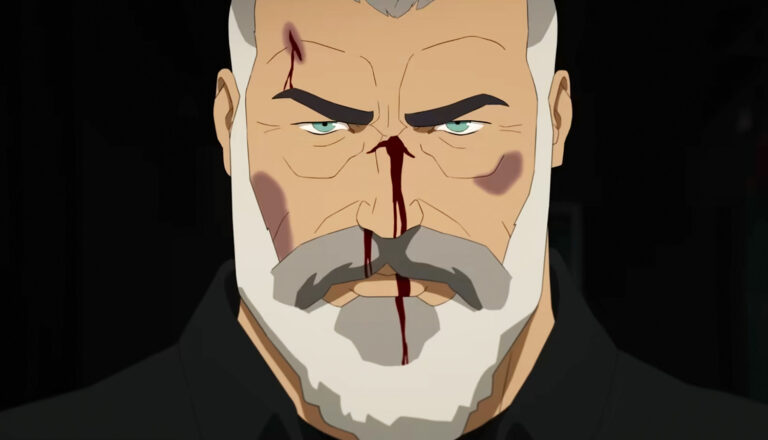
The Neighborhood
The Neighborhood, like all neighborhoods, isn’t free from problems. But it feels relatively safe.

Death is not the end. Unfortunately.
Welcome to, well, the indeterminate future, wherein death is a serious-but-not-final bummer for some and a mere inconvenience for others. Technology hands folks the ability to live after their bodies have long since conked out: They download their conscious selves into what’s called a “stack,” which in turn is nestled in semi-used bodies, or “sleeves,” allowing them to live on.
Think of it as a world where everything we truly are—our minds, our souls, our spirits—can be stored on a flash drive, and where we’re able to download that identity data onto an empty, organic machine that just happens to be lying around.
Great, right?
Or not. See, sleeves are expensive. The best ones cost a small fortune. Even a minor upgrade is more than most folks can afford, which means that near-immortality is in the hands of the super-rich: Some even clone their own bodies, changing them out whenever the mood strikes. And then, of course, there’s always the chance that you just might get your stack destroyed, and then you’re really, truly gone. Kaput. Off to whatever afterlife this dystopian universe affords.
But what happens when one of society’s one-percent of one-percenters—a guy who fully expects to re-sleeve himself until the sun cools—gets his stack smashed in?
That’s when things get really strange.
Laurens Bancroft is known as a Meth—taken from the biblical name Methuselah. He’s 360 years old now, and he’s super-bummed that someone killed him not so long ago. They didn’t just scrap his sleeve, but blasted his stack, too¬—a very thorough hit, indeed. Good thing he had his essence saved on a satellite backup drive, one that refreshes every 48 hours or so, and an extra cloned sleeve to boot. But unfortunately, the backup didn’t record the details of his own death: Bancroft has no idea who his killer is.
So, because money really can buy pert near everything in this world, he pays to resurrect Takeshi Kovacs, who has spent the last 250 years cooling his heels in an icy pool of goo.
Kovacs was what was once known as an Envoy, a super soldier who was equipped psychologically to deal with the repeated re-sleevings his job entailed. But Kovacs went rogue, and the establishment threw him into permanent limbo for espionage, terrorism and, in the words of one fellow, “more murders than I can count.”
But no one’s better equipped to find Laurens’ killer, and Laurens promises to pay handsomely for Kovacs’ services—including giving him a full and unconditional pardon. If successful, Kovacs will, almost literally, have a new lease on life.
But it won’t be easy to bring Laurens’ killers to justice. And it sure won’t be pretty.
This is not to say we don’t see pretty people in Netflix’s Altered Carbon. Indeed, we see plenty of them—and plenty of them.
Men are seen fully naked. We don’t see complete full-frontal female nudity, but the show only avoids it by the barest of technicalities (and coverings). Women and some men are horrifically objectified here, with their near-nude images proliferating on three-dimensional ads, in high-tech strip clubs and in virtual-reality brothels. I’m guessing that the folks at Netflix would argue that all this sex and nudity underlines and illustrates this sci-fi society’s moral bankruptcy; but there’s a bit of irony in Netflix then streaming all that moral bankruptcy straight into our living rooms.
The show is exceedingly violent as well. Blood and brain matter and all the body’s gory accoutrements fly and spatter. And we’ve not talked about the language (atrocious) or the drinking (frequent) or the smoking (which you’d think would’ve been snuffed out by now, but whatever).
Altered Carbon had a bit of promise in its premise. It even flirts at times with the spiritual questions that such constant temporal re-spawnings would naturally lead to. But as a finished product, this much-buzzed-about Netflix series leaves a lot to be desired and very little to the imagination. I’d not alter my schedule one little whit to watch this dystopian drama.
(Editor’s Note: Plugged In is rarely able to watch every episode of a given series for review. As such, there’s always a chance that you might see a problem that we didn’t. If you notice content that you feel should be included in our review, send us an email at letters@pluggedin.com, or contact us via Facebook or Instagram, and be sure to let us know the episode number, title and season so that we can check it out.)
Rich guy Laurens resurrects and “leases” Takeshi Kovacs, a convicted killer who’s been in suspended animation for the last 250 years: Laurens believes that Kovacs can find the man who “killed” him. (Thankfully, Laurens had a backup of his mind and a spare body just lying around.)
We see what was apparently left of Laurens’ head—bloody spackle, essentially—coating a nearby wall. Kovacs seems inclined to turn down the gig, but hopes to take advantage of this unexpected vacation back into consciousness. So he buys a bevy of drugs, gets stoned and wanders down streets filled with R-rated holograms (we see mostly nude women dancing, a man apparently soliciting a gay clientele and a trio involved in sexual activity). He stumbles into a virtual-reality sex hostel, where “services” are again advertised via mostly nude holograms. Elsewhere, he visits a virtual strip club, where topless women dance, writhe and flirt.
In a previous “sleeve” (body), Kovacs has sex with a woman (with suggestive movements and the near nudity). When Kovacs is initially revived, he’s completely naked: We see him from the side, rear and partially from front (though his genitals are obscured by a table). Another flashback (or perhaps a vision of some sort) shows two women showering and engaging in foreplay. Another woman wears a revealingly clingy dress.
Men and women are all shot repeatedly, often accompanied by bursts and sprays of blood. One person gets hit in the neck, an act that in the show’s premise kills the person permanently. Soldiers are shot grotesquely through the head. A couple of them are also neutralized, presumably terminally, via an electric shock. Combatants get hit, kicked, kneed, elbowed, thrown aside and choked. Someone’s stabbed. We hear a discussion about suicide, and someone contemplates killing himself.
Religious protesters rally outside a facility, insisting that the process of “re-sleeving” is against God’s will. “God is watching!” someone says to Kovacs. “He will judge you for your sins!” (“That’ll keep Him busy for a while,” Kovacs mutters in response.) We hear references to a diocese and meditation, and Laurens is called a “Meth,” a reference to Methuselah. Characters drink frequently, and Laurens’ son is picked up for driving under the influence. Kovacs smokes. Characters say the f-word nearly 30 times and the s-word seven times. God’s name is paired with “d–n” five times. We also hear “a–,” “b–ch,” “d–k” and “h—.”

Paul Asay has been part of the Plugged In staff since 2007, watching and reviewing roughly 15 quintillion movies and television shows. He’s written for a number of other publications, too, including Time, The Washington Post and Christianity Today. The author of several books, Paul loves to find spirituality in unexpected places, including popular entertainment, and he loves all things superhero. His vices include James Bond films, Mountain Dew and terrible B-grade movies. He’s married, has two children and a neurotic dog, runs marathons on occasion and hopes to someday own his own tuxedo. Feel free to follow him on Twitter @AsayPaul.

The Neighborhood, like all neighborhoods, isn’t free from problems. But it feels relatively safe.

In CBS’s DMV, the East Hollywood DMV branch faces a possible shut down. While Barb fights to keep her branch open, Colette fights for the attention of her office crush.

Netflix picked a fitting name for ‘Splinter Cell: Deathwatch’: You watch people die a lot in this animated show.

Where’s the fire? In Chicago, it seems. But the flames outside Firehouse 51 are nothing compared to the heat generated inside.